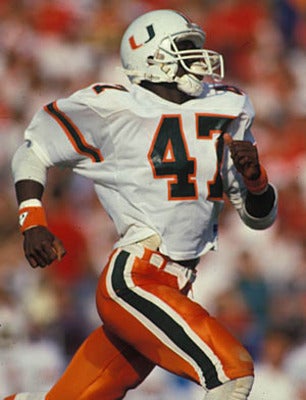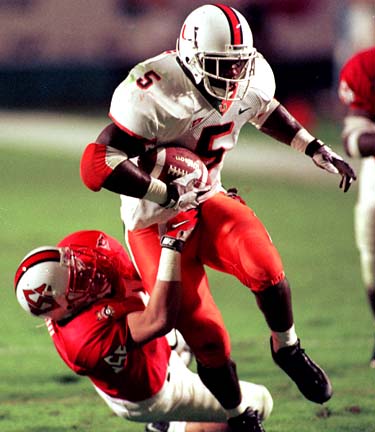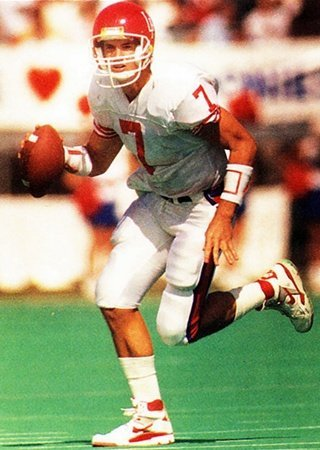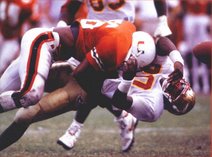 |
| Michael Irvin (Photo Credit: Associated Press) |
Written By: Nathan Skinner (@Canedude08)
@CanesRisingBlog Contributor
The wide receiver position is one that attacts players who are a little bit different. From the overly verbose attention seeker, to the insanely quiet, the position attracts everyone. Miami has featured receivers of every type, and personality over the last 50 years. These players all helped make The U the Apple of offensive football. Miami did it differently, and everyone had to scramble to catch up.
Miami's Best Receivers
1. Michael Irvin (1985-1987)
Very few people are the personification of an athletic program. While Alabama worships at the altar of Bear Bryant, and Notre Dame sings the praises of Knute Rockne, Miami is all about The Playmaker. For better or worse, Irvin is Miami football, and his story is not only the story of a football program, but of a University and a city. Irvin is arrogant, brash, and all over the Miami record books. During his three year career, Irvin caught 143 passes, gained 2,423 yards, and scored 26 touchdowns. Irvin was not only the leading receiver on the '87 National Champs, he made the biggest play of the season, scampering 73 yards for the game winning score against Florida State.
2. Andre Johnson (2000-2002)
Andre Johnson is the wide receiver sent from central casting, a physical specimen only seen on the covers of comic books. 'Dre had to wait his turn as he was stuck behind Santana Moss and Reggie Wayne on the depth chart, but when finally unleashed, he proved to be worth the wait. In 2001, Johnson was a difference maker, averaging over eighteen yards per catch, as he helped lead Miami to the 2001 National Championship. He was even better in 2002 as he gained over one thousand yards, on only 52 catches. What makes 'Dre so unique is his physical ability. While players like Michael Irvin and Reggie Wayne were big receivers, Johnson was more than a big body. He mauled opposing corners, and had the speed to run away from defenders, once he made the catch. DeJuan Groce was once a talented corner with NFL aspirations, that is until 'Dre demolished him in the 2002 Rose Bowl. In that game, Andre Johnson was named the Co-Most Valuable Player, and was the one player Nebraska couldn't contain.
3. Eddie Brown (1983-1984)
Before Michael, before 'Dre, before every other player named in this article, there was Mr. Brown. Ed was the first outstanding Miami receiver, and served as Bernie Kosar's security blanket during the 1983 National Championship season. While Brown only played two years in Orange and Green, he was a dominant force, gaining 1,754 yards, and averaging 19.7 yards per catch. Brown was a popular target in the redzone, catching fourteen touchdowns in two seasons. Eddie was named a consensus All-American in 1984, as Miami possessed one of the best offenses in the country under offensive guru Gary Stevens.
4. Santana Moss (1997-2000)
Some people are fast on a track, others are fast on the football field, and a select few can run anywhere. Santana Moss was fast on the track, on the football field, he's probably fast on the moon, or Saturn. Moss came to Miami on a track scholarship, that's the only way Butch Davis could get the talented player to Coral Gables, thanks to NCAA mandated scholarship restrictions. Eventually, Santana earned a football scholarship, and blossomed into the best "smurf" receiver in program history. During his four year career, Moss caught 143 passes, and gained 2,547 yards. Santana scored nineteen receiving touchdowns, and also scored on punt returns and reverses. Devin Hester may be the most famous Miami return man, but Moss was the best, he rarely made mistakes in the return game, and could avoid people in a phone booth. Moss was a key player during Miami's rebirth, and when the team came of age, he reaped some of the benefits. He was named a Consensus All-American in 2000, and finished seventh in the 2000 Heisman Trophy balloting.
5. Reggie Wayne (1997-2000)
There were only three things Miami fans could count on in the late 90s: Death, Taxes, and Reggie Wayne making a huge catch on 3rd down. While Santana Moss was the big play threat, the guy who could take your breath away, Reggie was the player you could always depend on. Reggie Wayne was extremely consistent, catching at least forty passes and gaining over 450 yards in each of his four seasons. His senior year was his best one, as he caught 43 passes, gained 755 yards, and scored ten touchdowns. Wayne was deadly in the red zone, as his superior route running skills and soft hands made him an inviting target for Miami quarterbacks. One can only imagine how many catches Santana Moss took away from Wayne, and vice versa. Wayne was part of the best receiving tandem in program history.
6. Lamar Thomas (1989-1992)
There are few guys on this list who fit the "Decade of Dominance" stereotype like Lamar Thomas. A talented, but extremely brash receiver, Thomas was a speed demon, averaging 15.8 yards per reception during his career. He was a bit player on Miami's 1989 National Championship team, but came into his own in 1990, snagging 43 receptions for 742 yards. He was the favored target of Gino Torretta in 1991, scoring six touchdowns, as he helped lead Miami to a National Championship. If you don't remember the catch Lamar made in the
1992 Fedex Orange Bowl, feel free to jog your memory.
7. Wesley Carroll (1989-1990)
This pick will be the one that leads to the most questions, but Wes Carroll was an outstanding receiver who has never been truly appreciated. Even though Carroll only played two years in Miami, he caught 114 passes, and scored eleven touchdowns. What made Wes unique was how many passes he caught. During the "Decade of Dominance", most Miami receivers caught around 40-45 passes, Carroll was one of the few to break the fifty reception mark, catching 53 in 1989, and 61 in 1990. Wesley was a perfect fit for Dennis Erickson's one back spread, he was an explosive player who couldn't be tackled in space.
8. Leonard Hankerson (2007-2010)
The youngest member of this list also has the most interesting story. Hankerson was a player who arrived in Coral Gables with a plethora of awards from his decorated high school career, but looked to be a colossal bust midway through his sophomore year. Following some intensive work with former Miami Dolphin Mark Duper, Hank emerged as one of the best receivers in program history. His senior year was arguably the best season ever put together by a Miami receiver. Hankerson hauled in 72 receptions, gained 1,156 yards, and scored 13 touchdowns in 2010. Leonard's work ethic carried him to success, and that trait is found in all of Miami's great receivers. While having outstanding natural talent helps, the players who leave a mark are the ones who worked the hardest. Hankerson worked extremely hard, and it showed in that amazing 2010 season.
9. Randal "Thrill" Hill (1987-1990) & Chris T. Jones (1991-1994)
It's time to shoot air pistols, and do the funky chicken, Thrill Hill is on the list. Randal Hill may have made Dennis Erickson laugh with his crazy antics, but opposing defenses weren't in on the joke. "Thrill" was speed personified, he ran at full speed at all times, and was looking to score every single time he touched the ball. Hill didn't start his Miami career at receiver, he was a lightly used defensive back, before he was moved to the offensive side, where he went on to total 1,643 receiving yards, and 11 touchdowns. C.T. couldn't find his way onto the field at the beginning of his career, but eventually became Frank Costa's favorite target in 1993, catching 45 passes, and scoring 4 touchdowns. Jones was a physical receiver, who used his freakishly long arms to ward off defenders who dared jam him at the line of scrimmage.
10. Brian Blades (1984-1987)
We may remember Brian Blades as Bennie's brother, but Brian was a star in his own right. Michael Irvin got the headlines, he was the guy wearing the chunky gold chains, but Blades was the guy stretching the field vertically. Brian was an outstanding receiver, catching 80 passes during his career, and averaging over 18 yards per reception. Whenever Vinny Testaverde or Steve Walsh wanted to break a game open, they looked for #9.
Honorable Mention: Ray Bellamy (1968-1969)
Ray Bellamy isn't on the list merely because of statistical achievements, he's on this list because he was a pioneer. Bellamy was the first African-American 'Cane, and the student-athlete whose grace, dignity, and outstanding ability made it possible for Miami to become The U. His career was cut short by a horrific injury suffered in a car accident, but that didn't stop Bellamy from averaging 15.8 yards per reception in two seasons.












